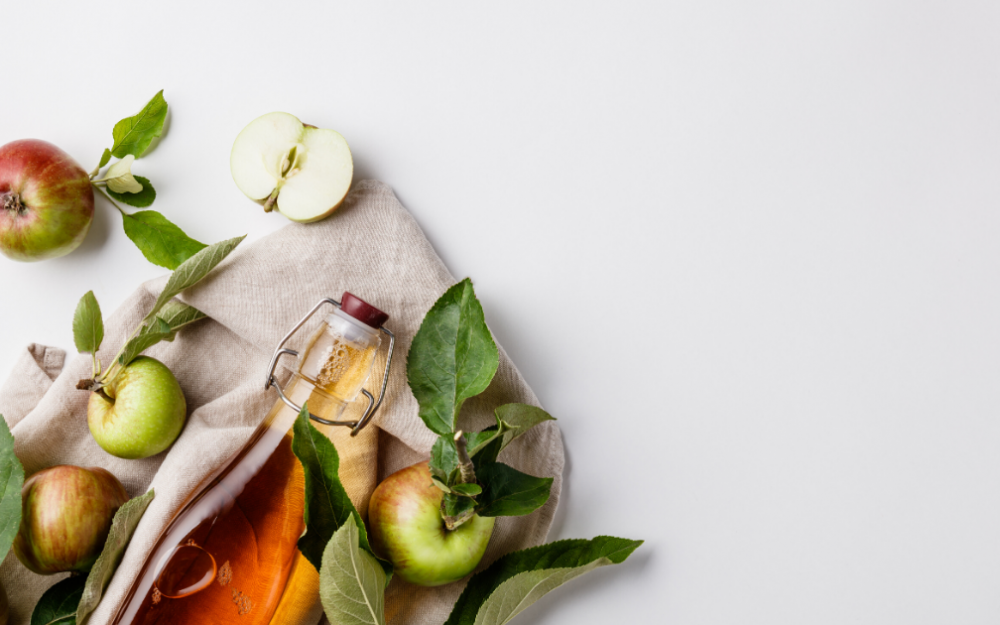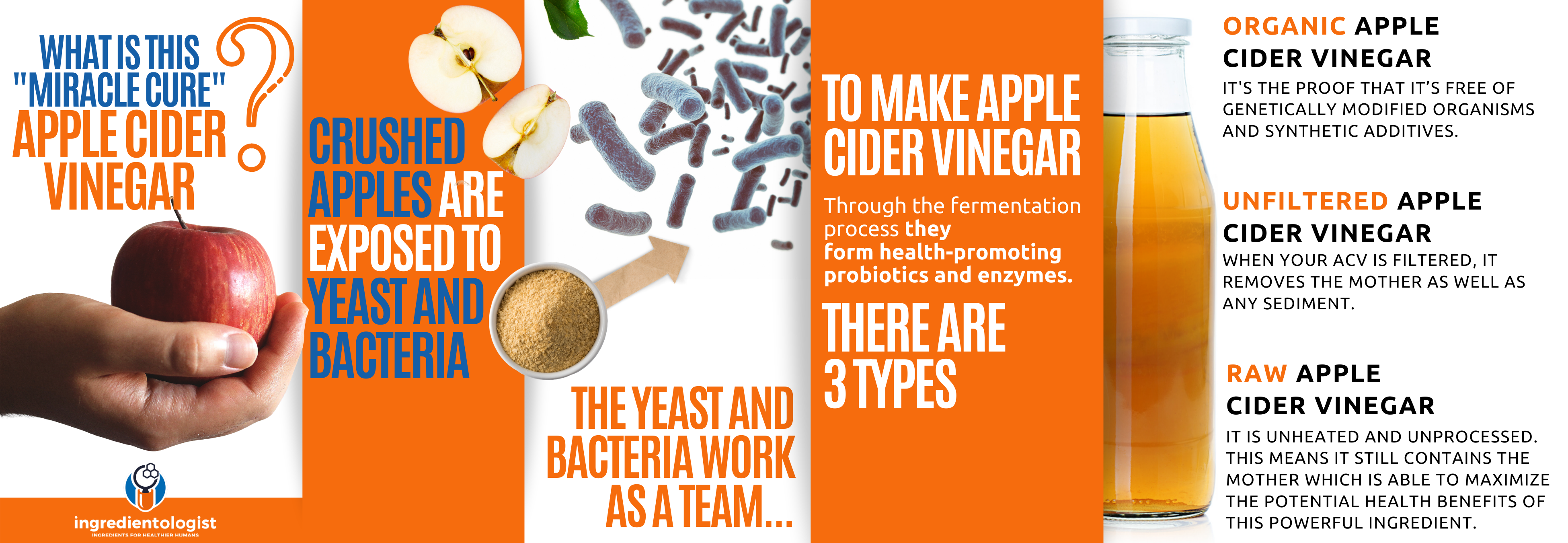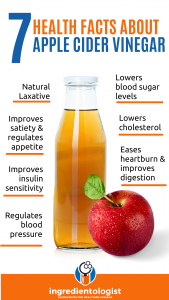Apple cider vinegar has become all the craze lately. This new hype is actually ‘old news’ as apple cider vinegar is one of the oldest known natural health remedies, and has been used medicinally for years! We’re just becoming more aware of these benefits. It is simply a re-discovery.
Apple cider vinegar (ACV) is talked about everywhere as people look to improve their health in more natural ways. The natural product has high levels of acetic acid, among other compounds, which are responsible for its supposed health benefits of which improved glucose and fat metabolism are most desired. It’s a common pantry staple and is often taken as a supplement in small quantities to help with digestion,
You may have heard of people who swear by taking a shot of ACV in the morning and they wouldn’t be the same without it. All this hype around this seemingly simple pantry item is totally valid, as most of the health benefits are backed by science.
WHAT IS APPLE CIDER VINEGAR?

Crushed apples are exposed to yeast and bacteria to make ACV. It is essentially fermented apples. This is how apple cider is made, but with a second fermentation, instead of just one, the cider is turned into vinegar.
The yeast and bacteria work as a team. Yeast digest the sugars from the apples into alcohol while the bacteria, called acetobacter, convert the alcohol into acetic acid.
Many ACV labels will say ‘contains the mother’, which sounds absurd, but the ‘mother’ is the clumps and strands that you see floating around. This is the yeast and bacteria that continue to ferment the apples and is completely safe to consume. You can buy filtered or distilled ACV which is clear, but the raw, unpasteurized version is cloudy with the mother floating around.
Some argue that the mother is responsible for all of ACV’s health benefits. This is partly true since the mother is a probiotic, but the majority of the benefits may come from the acetic acid made by the bacteria. Other organic acids such as citric, formic, malic, lactic and succinic acid are also produced as by products of the bacterial fermentation, while acetic acid appears to be the major player here.
On top of the probiotics and acetic acid, ACV contains some minerals that apples do, as well as some polyphenols (plant-based antioxidants). The real bonus is that ACV comes with almost no sugar load compared to apples, thanks to the fermentation of the sugars in the apples.
So, by converting the often unwanted, and sometimes health-negating sugars in apples into something that actually improves our health via a natural process that has been around for thousands of years, we have a powerful natural health remedy that’s widely available and affordable.

WHAT ARE THE HEALTH BENEFITS?

There is little high quality evidence that supports the purported benefits of ACV and the science that has been done is usually done using other vinegars. With that said, ACV should be taken as a supplement to a healthy lifestyle, and not used as a means to achieve health on its own.
On a surface level, the main benefits of ACV are:
- A natural laxative
- Ease heartburn & improve digestion
- Improves satiety & regulates appetite
- Lower blood sugar levels
- Improves insulin sensitivity
- Regulates blood pressure
- Lowers cholesterol
THE SCIENCE
Apple cider vinegar’s many beneficial effects are attributed to the ‘mother’ as a probiotic, the acetic acid produced and the polyphenols present in the apples themselves. Let’s geek out a little on how these apples magically turn into a liquid that claims to cure many health problems.
ACETIC ACID
The fermentation of alcohol by bacteria called acetobacter produces acetic acid and is what makes ACV acidic, as you might have guessed. It is also responsible for ACV’s many benefits.
Acetic acid (C2H4O2) is a short-chain fatty acid with 2 carbons in its chain length. In its pure form, it is a clear liquid that has a very strong smell and is extremely corrosive to the skin. It is not safe to consume! But, all vinegar contains acetic acid, in amounts that are safe to consume. To get a better understanding, let’s take a look at the difference between white vinegar and apple cider vinegar.
White vinegar: It is sometimes called spirit vinegar and is clear or white in color. It is made from the fermentation of grain alcohol. It can be used for cooking or baking and is a powerful antimicrobial making it a good household cleaning agent. It contains 4 to 7% acetic acid and 93 to 96% water.
Apple cider vinegar: It is brown in color, often murky, and is made from apple juice going through a two-step fermentation process. It is more versatile when used for cooking, and has greater nutritional value than white vinegar because of the fruit it came from. It contains 5 to 6% acetic acid and 94 to 95% water.2,19
As mentioned, acetic acid is produced by bacterial fermentation in ACV, but it is also produced naturally inside our gut by our own gut bacteria. The bacteria in our gut ferment indigestible fibers producing short-chain fatty acid (SCFA) as end products that go on to confer many beneficial metabolic effects. Acetic acid is the most abundant SCFA that our gut bacteria produce, with propionate and butyrate also being made. They each have distinct functions:
- Acetate enters the peripheral circulation to be metabolized by peripheral tissues.
- Propionate is largely taken up by the liver.
- Butyrate is the major energy source for colonocytes.
These SCFA are present in our large intestine (colon) in a ratio of 60:20:20, respectively. Once acetic acid is absorbed from the gut and into the bloodstream it acts on various tissues around the body like muscle, fat and liver by binding to certain proteins.18
Acetic acid has numerous studies backing its ability combat the obese, insulin resistant state. Most notably, by regulating blood glucose and insulin responses to meals and improving insulin sensitivity. It is also well known to increase satiety by stimulating specific hormones that affect appetite. In fact, it plays such an important role in weight control and blood sugar balance that medical professionals have looked to “oral acetate administration (vinegar intake), colonic acetate infusions, acetogenic fiber, and acetogenic probiotic administrations as approaches to combat obesity and comorbidities”.
Any increase in the amount of acetic acid present in the gut is thought to be beneficial. This is part of the reason why we take probiotics, prebiotics and postbiotics; to increase acetic acid in the gut. We can obtain acetic acid from dietary sources (vinegar or ACV), it is produced naturally within our gut from the fermentation of fiber in our diet and it is increased with prebiotic and probiotic administration.
In summary, acetic acid has been shown to act in various ways in the body:
- Increased energy expenditure
- Browning of white adipose tissue
- Improved glucose uptake
- Improved insulin sensitivity
- Increased satiety
- Anti-inflammatory
- Increased fat and glucose oxidation in the liver

Figure 1Acetate sources and acetate-mediated effects in metabolic health.
The fact that acetic acid has these many beneficial effects is promising for ACV as a supplement, however, more research is needed on this ancient natural remedy itself.
OTHER BIOACTIVE COMPOUNDS:
Polyphenols
Now let’s get back to ACV and what makes it better than regular grain-derived vinegar. Because ACV is derived from fruit it contains phenolic compounds or polyphenols which are plant compounds with powerful antioxidant properties. These compounds are known to scavenge free radicals or reduce oxidative stress in our cells.
Studies have shown that ACV contains3:
- gallic acid
- catechin
- epicatechin
- chlorogenic acid
- caffeic acid
- p‐coumaric acid
Depending on the total phenolic content of a particular product, ACV may be a good supplement to add to your antioxidant stack.
Minerals
100g of ACV contains the following minerals4:
Minerals %DV Quantity
Calcium 1% 7 mg
Iron 2% 0.20 mg
Magnesium 1% 5 mg
Phosphorus 1% 8 mg
Potassium 2% 73 mg
Sodium 0% 5 mg
Zinc 0% 0.04 mg
WEIGHT LOSS
Historically, ACV has been used as an antibiotic, It goes without saying that any supplement that is aimed at weight loss should be coupled with a healthy, whole-foods-based diet that is low in processed foods and a regular amount of exercise. The same is true for ACV.
One study examined the effects of ACV on 39 overweight or obese people on a ‘restricted calorie diet’. ACV reduced body weight, waist circumference, body mass index (BMI), plasma triglycerides, total cholesterol, visceral fat and appetite score, while it increased HDL – the ‘good’ cholesterol. All of these markers are indicative of improved metabolic health and support weight loss. However, this was a small group examined for a relatively short period of time and the subjects were following a restricted calorie diet and they exercised.5
The evidence behind ACV for weight loss is poor, and more work is needed. The many beneficial effects on weight control are likely because of the appetite regulating effects of ACV and not the fact that it causes you to burn more fat, as many products lead you to believe.
BLOOD SUGAR & INSULIN CONTROL
I have talked about how frequent spikes in our blood glucose can lead to a state of insulin resistance. This just means that after a meal, our cells lose the ability to respond to insulin effectively, leaving high sugar levels in the blood instead of allowing it to enter our cells to be used for fuel. As this spike in our blood glucose occurs more and more, our cells start to become resistant to insulin. Insulin resistance is one of the biggest indicators of diabetes, obesity and other metabolic diseases.
Several experiments have analyzed the ‘antiglycemic’ or blood glucose lowering effect of vinegars, while a select few have looked at ACV specifically. The mechanism is likely attributed to the acetic acid present in all vinegars in slightly different amounts.3
Interestingly, ACV has been shown to reduce the blood glucose spike after a meal that contains carbohydrates. One study showed glucose levels in the blood to be 20% lower when acetic acid (as vinegar) was ingested with a carbohydrate containing meal.6
ACV was also shown to slow gastric emptying (delay the rate at which food leaves the stomach), which prevented a quick spike in blood glucose by slowing the rate at which sugar enters the bloodstream. This effect lowered both the blood glucose as well as the insulin response to a starchy meal. This is beneficial to diabetics and anyone looking to be metabolically healthy.8
Another study in humans showed that vinegar increased the glucose uptake by cells in forearm muscle and decreased the amount of insulin released after a meal. Again, two changes that are beneficial to improving insulin resistance.7
SATIETY & APPETITE
The weight loss benefits of ACV are largely due to its ability to increase a person’s satiety in response to a meal. Greater satiety significantly reduces the amount of food you eat, indirectly leading to weight loss. A study examining the effects of acetic acid on satiety after a meal of white bread showed that levels of satiety was increased in 12 healthy individuals.
The acetic acid stimulates the secretion of two important gut hormones; glucagon-like peptide-1 (GLP-1) and peptide YY (PYY) which send a signal of satiety to the brain.
LOWER CHOLESTEROL
The cholesterol-lowering effect of ACV has been reported with one study showing that ACV supplementation lowered total cholesterol, LDL cholesterol and triglyceride levels while increasing HDL in the blood.
ANTIOXIDANT (ROS)
Reactive oxygen species that build up inside our cells are known to cause damage to our fats, proteins and DNA which results in accelerated aging. The phenolic compounds that are found in vinegar (discussed above) have an antioxidant effect, reducing the activity of ROS.
Oxidation of LDL particles is what leads to and worsens the highly inflammatory chronic condition of atherosclerosis. Chlorogenic acid, a polyphenol present in high amounts in ACV may reduce the oxidation of LDL particles.3
ANTIBACTERIAL
In some food products, ACV and other vinegars are used as a food preservative thanks to its antibacterial properties. The acetic acid in vinegars can inhibit the growth of bacteria in foods by getting into the cells and killing them. Among all of the organic acids present in vinegar, acetic acid was shown to be the most effective at killing E. coli (a common type of bacteria), followed by lactic, citric and malic acids.3,17
SKIN HEALTH
There is limited evidence supporting ACV’s ability to treat some skin conditions such as eczema and psoriasis. It is always cautioned however that you should only apply diluted ACV to the skin as pure vinegar can cause burns.17
IMPROVE DIGESTION
A common use for ACV is to improve digestion, treat acid reflux and to reduce bloating. There is no clear science that supports these claims, however there are many anecdotal reports about ACV improving digestion.
MORE USES

Food preparation: Apple cider vinegar is a well-known supplement now, taken as shots or even pills, but it truly belongs in the pantry, or at least it has a place there. As a food item, ACV is commonly used in salad dressings and vinaigrettes or for marinating or pickling, It is also a great way to give your water some flavor or as an ingredient for a health elixir to sip on.1, 16
Most interestingly, a recent study looked at whether spraying meat with vinegar before cooking affected the formation of polycyclic aromatic hydrocarbons (PAH). They found that ACV caused a 66% decrease in the amount of PAH formed during the cooking process in charcoal-grilled pork loin!10
Cleaning/Beauty: According to the Environmental Working Group, Apple cider vinegar is overwhelmingly safe. In fact, it is considered to be a ‘low’ overall hazard in beauty products and safe as an ingredient for cleaning agents. You’ll find ACV in many natural shampoos, soaps and moisturizers. It is also used for bug bites, stings and for sunburn. Because of its antibacterial properties, its use on wounds and skin disorders is fairly common, but caution must be taken to dilute ACV to avoid further damaging the skin.14, 15
ADDING ACV TO YOUR SUPPLEMENT STACK
Look for raw and organic ACV products. Read the label carefully to see what the percentage of acetic acid is and what the polyphenol content is. This may not be shown, but can set apart a good and bad quality product.
Choose unfiltered and unpasteurized products which you can identify straight away by the murkiness and the strands of the ‘mother’ floating around. Although this may look rather off-putting, it is completely safe to consume and contains healthy bacteria, enzymes and amino acids! Filtered ACV will be a clear, light brown colour in contrast.
You’ll find ACV in the grocery store as a pantry item, but it will most likely also be in the supplement aisle where it can be in liquid or tablet form. Wherever you get it, just make sure you read the ingredients and that it says ‘apple cider vinegar’ and not acetic acid or white vinegar.
HOW TO TAKE ACV
As a liquid, you can either:
- Add ACV to salad dressings, marinades or use it for pickling.
- Add it to water or make a tonic using water, apple cider vinegar, lemon juice, cinnamon and cayenne pepper.
Always dilute ACV with water and rinse your mouth with water afterwards to minimize tooth exposure to acetic acid.
Some companies sell ACV in a tablet form which you may prefer if you don’t enjoy the taste. Just be sure to follow the dose instructions on the label.
Fasting: Many claim that taken in the morning on an empty stomach will make you burn more fat. This isn’t the case! WHat it will do, however, is control your appetite by increasing your satiety. This is why I like to use ACV while I am fasting. I add it to a big jug of water and sip on that throughout the day. If anything, it just adds flavor to my water and keeps me going without food.
With food: Even if you’re not diabetic or obese, reducing fluctutations in blood sugar and insulin should be a priority. Warding off insulin resistance is key to long term metabolic health. The research pointing to ACV’s ability to decrease spike in blood glucose and insulin after a meal suggests that adding a tablespoon or two just before or during a meal is a good idea.
I always use Braggs Apple Cider Vinegar as they’re a well-trusted brand that is organic and unfiltered, containing the ‘mother’.
If you feel nauseous after taking ACV on an empty stomach, consider taking less or diluting it down a little more.
DOSE
There is no standard recommendation so, depending on who you ask, the dose of ACV may differ. It also depends on how you take it. If you’re taking it as a supplement, it is best to stick to 1 – 2 tbsp at a time, diluted in some water. It is best taken just before or during a meal if you’re just starting out.
If you’re using it to prepare food, it is likely that the dose is less important, however you should be aware that ACV does come with a few side effects. Remember, just because it is a natural product does not mean that it can be taken in large amounts.
WHEN TO BE CAUTIOUS
- Make sure you trust the brand you are buying. Sometimes a company may use plain vinegar. And be sure about the acid level as some may contain a higher acid level than the expected 5 – 6% of ACV.
- Taking ACV too frequently can cause the enamel on your teeth to decay due to its acidity.12
- Too much ACV was shown to cause potassium levels to be depleted in one case report, which is particularly a concern if you have high blood pressure.16
- Diabetics should be wary of taking ACV while taking insulin medication, as it can alter insulin levels and may cause low blood sugar.11
- Nausea is a common side effect, especially when taken on an empty stomach.
Traditionally used in food preparation, and with many years used as a natural remedy, ACV has now received a lot of attention for its therapeutic benefits. While more large-scale and long-term clinical research is needed, there is a good reason to incorporate ACV into your diet with its anti-diabetic and antioxidant effects being the most well-backed. However, small doses are recommended as more is definitely not better when it comes to ACV.
Have you been using ACV in your daily supplement stack? I’d love to know when you take it and what benefits you’ve had. It is definitely one of my go-to’s, especially during a long fast. If you haven’t been using it, why not give it a try with your next meal. A fun experiment would be to test your blood glucose 30, 60 and 120 minutes after a meal with and without taking ACV and see if you notice a difference!
Tag me in your experiments, and let me know if you have any questions in the comments on my Instagram page. Head over there now to share this with your friends and family.
Original blog may be found directly on Shawn's site here!
Stay connected with Shawn Wells:
- Instagram @ingredientologist
- Facebook /Ingredientologist
- LinkedIn /zonehalo
- shawnwells.com
Want to be featured by ICON Meals? Submit your stories to info@iconmeals.com or send us a DM on IG or Facebook!
REFERENCES
- https://www.uchicagomedicine.org/forefront/health-and-wellness-articles/debunking-the-health-benefits-of-apple-cider-vinegar
- Hernández MAG, Canfora EE, Jocken JWE, Blaak EE. The Short-Chain Fatty Acid Acetate in Body Weight Control and Insulin Sensitivity. Nutrients. 2019;11(8):1943. Published 2019 Aug 18. doi:10.3390/nu11081943
- Properties of vinegar: Budak NH, Aykin E, Seydim AC, Greene AK, Guzel-Seydim ZB. Functional properties of vinegar. J Food Sci. 2014;79(5):R757‐R764. doi:10.1111/1750-3841.12434
- https://en.wikipedia.org/wiki/Apple_cider_vinegar
- Weight loss study: Solaleh Sadat Khezri, Atoosa Saidpour, Nima Hosseinzadeh, Zohreh Amiri. Beneficial effects of Apple Cider Vinegar on weight management, Visceral Adiposity Index and lipid profile in overweight or obese subjects receiving restricted calorie diet: A randomized clinical trial. Journal of Functional Foods, Volume 43, 2018. doi.org/10.1016/j.jff.2018.02.003
- Blood glucose: Johnston CS, Steplewska I, Long CA, Harris LN, Ryals RH. Examination of the antiglycemic properties of vinegar in healthy adults. Ann Nutr Metab. 2010;56(1):74‐79. doi:10.1159/000272133
- Insulin response: Mitrou P, Petsiou E, Papakonstantinou E, et al. The role of acetic acid on glucose uptake and blood flow rates in the skeletal muscle in humans with impaired glucose tolerance. Eur J Clin Nutr. 2015;69(6):734‐739. doi:10.1038/ejcn.2014.289
- Liljeberg H, Björck I. Delayed gastric emptying rate may explain improved glycaemia in healthy subjects to a starchy meal with added vinegar. Eur J Clin Nutr. 1998;52(5):368‐371. doi:10.1038/sj.ejcn.1600572
- Satiety: Ostman E, Granfeldt Y, Persson L, Björck I. Vinegar supplementation lowers glucose and insulin responses and increases satiety after a bread meal in healthy subjects. Eur J Clin Nutr. 2005;59(9):983‐988. doi:10.1038/sj.ejcn.1602197
- PAH: Tânia Cordeiro, Olga Viegas, Marta Silva, Zita E. Martins, Iva Fernandes, Isabel M.L.P.V.O. Ferreira, Olívia Pinho, Nuno Mateus, Conceição Calhau. Inhibitory effect of vinegars on the formation of polycyclic aromatic hydrocarbons in charcoal-grilled pork. Meat Science, Volume 167, 2020, 108083 ISSN 0309-1740. doi.org/10.1016/j.meatsci.2020.108083.
- Caution diabetics: Hlebowicz J, Darwiche G, Björgell O, Almér LO. Effect of apple cider vinegar on delayed gastric emptying in patients with type 1 diabetes mellitus: a pilot study. BMC Gastroenterol. 2007;7:46. Published 2007 Dec 20. doi:10.1186/1471-230X-7-46
- Tooth Erosion: Willershausen I, Weyer V, Schulte D, Lampe F, Buhre S, Willershausen B. In vitro study on dental erosion caused by different vinegar varieties using an electron microprobe. Clin Lab. 2014;60(5):783‐790. doi:10.7754/clin.lab.2013.130528
- Burn: Bunick CG, Lott JP, Warren CB, Galan A, Bolognia J, King BA. Chemical burn from topical apple cider vinegar. J Am Acad Dermatol. 2012;67(4):e143‐e144. doi:10.1016/j.jaad.2011.11.934
- https://www.ewg.org/skindeep/ingredients/700464-APPLE_CIDER_VINEGAR/#.Ws_NlS7wbct
- https://www.everydayhealth.com/diet-nutrition/diet/apple-cider-vinegar-nutrition-facts-health-benefits-risks-more/#benefits
- https://www.verywellhealth.com/apple-cider-vinegar-88768
- https://www.healthline.com/nutrition/6-proven-health-benefits-of-apple-cider-vinegar#1.-High-in-healthful-substances
- Wong JM, de Souza R, Kendall CW, Emam A, Jenkins DJ. Colonic health: fermentation and short chain fatty acids. J Clin Gastroenterol. 2006;40(3):235‐243. doi:10.1097/00004836-200603000-00015
- https://www.rd.com/food/fun/apple-cider-vinegar-vs-white-vinegar/